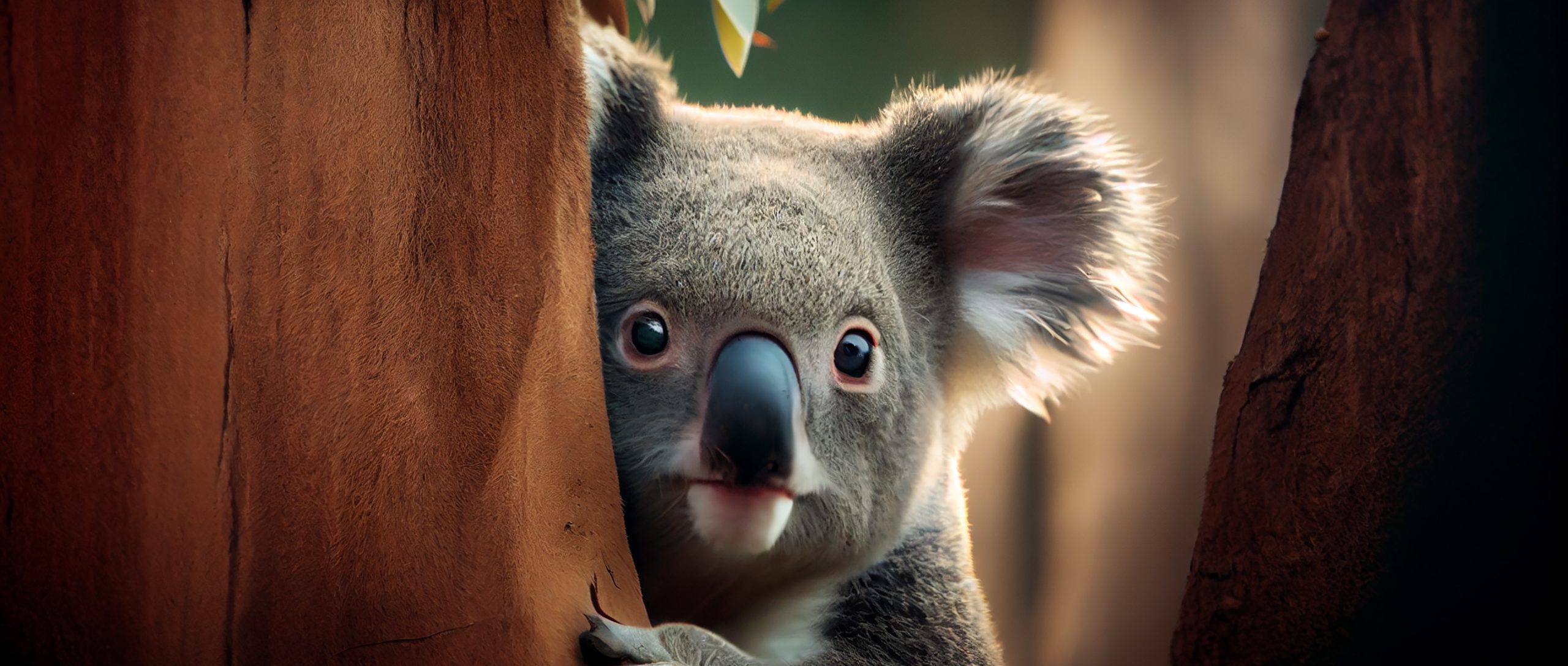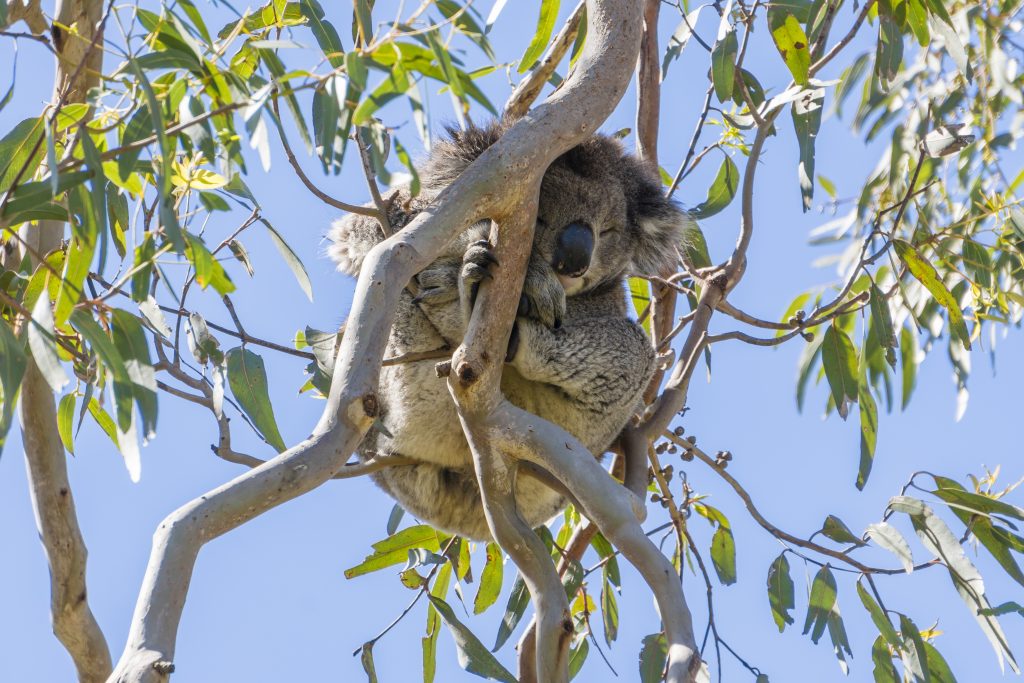
Koalas are Australian marsupials that have captured the hearts of people worldwide with their adorable appearance and unique lifestyle. Spotting these creatures can be quite a challenge, but we’ve been fortunate to have several koalas visit us at Long Point Conference Centre over the last few years. It’s been an absolute delight for our guests! Let’s look at 10 interesting facts about koalas, how we are preserving their habitats, and some frequently asked questions.
10 Interesting Facts About Koalas
1. Koalas have scent glands on their chest
Koalas have a fascinating habit of scent-marking their territory. They have scent glands located on their chest, and they rub their chests against trees to leave behind a musky scent. This behaviour not only establishes their presence but also communicates with other koalas in the area.
2. Specialised sharp-edged teeth
The unique teeth of the koala enables them to consume eucalyptus leaves effectively. Their molars have sharp edges and cusps designed to grind and shear the tough foliage. Additionally, koalas possess specialised teeth called incisors, which are used to scrape leaves off the branches.
3. Low water dependence
Native to Australia’s dry climate, koalas have evolved to be highly water-efficient. Eucalyptus leaves provide a minimal water, but koalas obtain most of their hydration from these leaves. They are capable of extracting moisture from the leaves while minimising water loss through their kidneys, enabling them to survive in their dry habitat.
4. A very unique digestive system
Koalas possess a specialised digestive system known as a “caecum.” This organ, located at the beginning of their large intestine, ferments the fibrous eucalyptus leaves. It contains bacteria that break down the leaves, extracting additional nutrients and aiding in digestion.
5. Koalas are solitary animals
Although koalas are generally solitary animals, they do have a social structure within their populations. Males have larger home ranges that overlap with several females. The size of a male’s home range depends on factors such as food availability, and it can vary from a couple of hundred metres to many kilometres.
6. They have two thumbs on each paw
Koalas are uniquely adapted to their arboreal (tree dwelling) lifestyle. Their paws have two thumbs, which provide them with excellent grip while climbing trees. They also have rough pads on their palms and soles to aid in gripping branches, preventing them from slipping or falling.
7. Startling snorting sounds
Have you ever wondered what sound a koala makes? Koalas communicate with each other through a range of vocalisations. The grunting sound that they make are in some ways quite similar to the grunts of a pig! Apart from their distinctive bellows, they also produce squeaks, growls and screams. These startling sounds play a crucial role in territory defence, mating rituals and social interactions within their population.
8. Koalas are not bears
Contrary to popular tourist beliefs, koalas are not bears – they belong to the marsupial family. Although they have a bear-like appearance, featuring round ears and a large black nose, koalas share more similarities with other marsupials such as wombats rather than actual bears.
9. Koalas sleep up to 20 hours in a day
Our cuddly-looking friends are well-known for their sleep habits. They spend the majority of their day resting or taking short naps, which helps them conserve energy for digesting their low-energy diet. This laid-back lifestyle also helps them manage their limited water intake since eucalyptus leaves have low water content. Although koalas can be active during the day, they are mostly roaming around at night time, which can make them a little tricky to spot at Long Point Conference Centre.
10. Males typically have a shorter lifespan
Male and female koalas have varying lifespans and body size. So how long does a koala live for? Male koalas, distinguished by their prominent scent gland in the chest, are larger than females. On average, male koalas live up to 12 years, while female koalas can have a longer lifespan of up to 15 years in the wild. When kept in captivity they tend to live a little longer than this.
Why Are Koalas Endangered in NSW?
Koalas in New South Wales are classified as a vulnerable species. Their populations have been declining due to various reasons. Some of the main factors are:
- Habitat loss. Destruction and division of their natural habitat through urbanisation, agriculture, logging and bushfires have greatly reduced suitable areas for koalas to live.
- Bushfires. Koalas are at risk during bushfires, which have become more frequent and intense due to climate change. Their slow movement and tree-dwelling lifestyle make it difficult for them to escape fast moving fires. Thankfully, RFS volunteers make a big effort to protect Long Point bushland.
- Disease and chlamydia. Koalas in NSW, like in other parts of Australia, suffer from diseases like chlamydia, leading to blindness, infertility and death. These diseases spread more easily among stressed and weakened koalas in fragmented populations.
- Road accidents. As urban areas expand, koalas increasingly encounter roads, resulting in a significant number of injuries and deaths from vehicle collisions.
- Harsh weather conditions. Rising temperatures, changing rainfall patterns, and more frequent droughts associated with climate change negatively affect koala food sources, such as eucalyptus leaves. Extreme weather events like heatwaves also cause heat stress and dehydration in koalas.
Koala Conservation Efforts
According to New Bush Telegraph, there are an estimated 600-1000 koalas in the south-west Sydney region. The conservation of koalas is of important to ensure their survival. Conservation organisations are actively working towards protecting their habitats, implementing tree planting programs and raising awareness about the importance of preserving koalas.
Volunteers at Long Point Conference Centre recently planted over 60 trees on site to help create habitats for koalas, which are quickly becoming an endangered species. In addition to this, the bushland surrounding the Long Point area is protected, and any actions such as cutting down gum trees require approval from the local council. This protection creates a safe and natural environment for native animals.

Other Frequently Asked Questions About Koalas
What is the scientific name for a koala?
The scientific name for a koala is Phascolarctos cinereus!
What does a koala need to survive?
Koalas need a variety of things to survive, but the main factors are:
- Food: Koalas need access to a good supply of eucalyptus leaves to meet their dietary needs. Each day an adult koala eats around 400-800 grams of leaves.
- Habitat: Koalas like to inhabit areas with a variety of eucalyptus tree species, particularly those with appropriate leaf nutrition and moisture content. Koalas spend most of their time in trees, seeking shelter, resting and feeding. Trees with large, sturdy branches allow koalas to move around and climb safely.
- Water: While koalas obtain a significant portion of their hydration from eucalyptus leaves, they still need access to water sources. They may drink water directly from streams, pools or rainwater collected in tree hollows.
- Interaction with others: Koalas rely on connected habitat patches to move between areas in search of food, mates and new territories. Social interaction is important for koalas to maintain bonds and mate within their populations.
- Protection from predators: Koalas are vulnerable to predation by certain species, including domestic dogs and foxes. Minimising interactions between koalas and potential threats are needed to ensure their survival.
How fast is a koala?
When koalas are on the ground, they typically move at a slow pace since their natural skills are more suited for climbing. However, if koalas get surprised or feel endangered, they have the ability to suddenly switch to a gallop, reaching speeds of around 30 kilometres per hour.
Where can I hold a koala in Sydney?
Koalas have sharp teeth and claws! It’s best to avoid touching or holding koalas in the wild as it can make them feel stressed and disrupt their natural behaviour. If you do come across one, maintain a safe distance and avoid direct contact to prevent any potential harm or injury. If you’d like to safely come close to one, you can visit places like sanctuaries and zoos that are trained to handle them. Two wildlife parks that are often recommended in the Sydney region are Featherdale Sydney Wildlife Park and Symbio Wildlife Park. If you are planning a school camp, these are two excellent places worth visiting as a school group in Sydney. If you aren’t so desperate to see koalas, but fauna and flora in general, the Australian Botanic Garden in Mount Annan is a beautiful place to explore, the most colourful time being spring.
Is it likely I’ll see a koala at Long Point Conference Centre?
Koalas come and go, so it’s actually difficult to say whether or not you’ll see a koala during your stay. If you’ve got some experience and knowledge, you might enjoy walking down the bush trails at night to look for some. Remember: koalas sleep for up to 20 hours a day and will likely be sleeping during the daytime. If you do come across one, remember to give them space!
Koalas in South-West Sydney
Koalas, with their unique adaptations and charming personalities, hold a special place in our hearts. By understanding their habits, supporting conservation efforts and spreading awareness, we can collectively contribute to ensuring a good future for koalas. Perhaps you’ll see some wildlife during your stay at Long Point Conference Centre.
Long Point Conference Centre is the perfect location for all kinds of group events, from action packed nature retreats to relaxing wellness retreats, from school camps to family reunions. Browse through the accommodation and activities we offer, or enquire here if you’re ready. We look forward to hearing from you!
